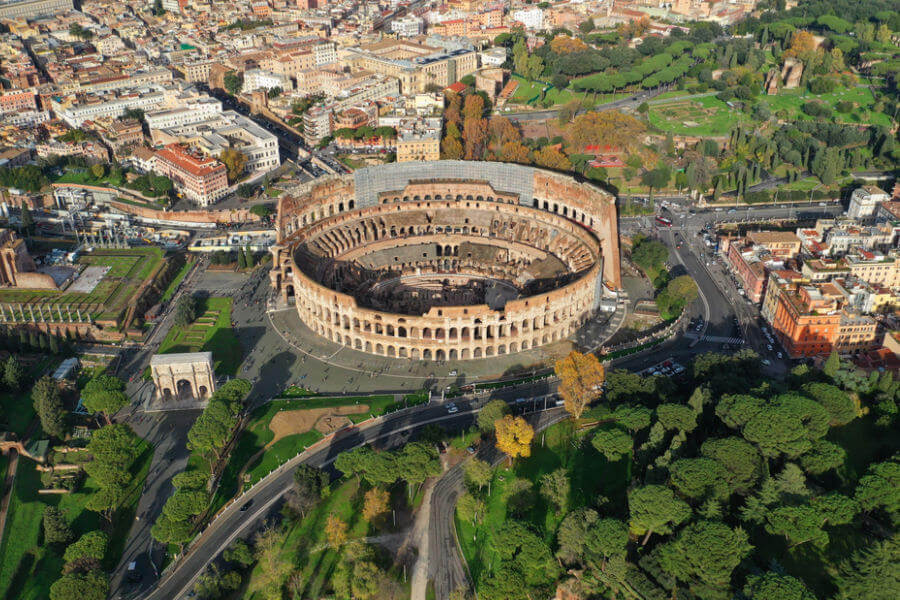The Colosseum is the symbol of Rome and represents the first and largest stable masonry amphitheater in the world.
In this article you will be able to find out when the Roman coliseum was built and some curiosities about it.
When was the Roman Colosseum built?
The Flavian Amphitheatre, commonly known as the Colosseum, was built between 72 and 80 AD under the commission of the Flavian Emperors, Vespasian and his son Tito.
It’s the biggest Roman amphitheater with 188 meters in length and over 50 meters in height. The Colosseum is nowadays the main symbol of the city of Rome and it’s one of the most visited sites in the city, counting over 6 million tourists every year.
Some curiosities about the Roman Colosseum

Back in ancient Rome…
Inaugurated with parties that lasted for 100 days, the Flavian Amphitheatre was a gathering place that could contain over 50.000 people at once where they would go enjoy all kinds of shows and spectacles. For more than 500 years, the Colosseum housed some of the most important exhibitions of particular exotic animals, gladiator fights, executions of prisoners and naval battles of ancient Rome.
A bit like going to see an action movie nowadays, the Colosseum was one of the most entertaining spots for ancient Romans. The last fight recorded in history that took place in the Colosseum was in the VI century. Since then, the Colosseum has survived many hardships; from earthquakes to World War II bombings but luckily most of it managed to remain intact.
Naumachie, the naval battles
Something that may have caught your eye from the list of shows that the Flavian Amphitheatre housed is probably the naval battles. You may be wondering how they could take place in a spot that had no water. The answer is actually really simple.
Staged naval battles called Naumachie, were one of the most popular forms of entertainment in Ancient Rome. The Colosseum would get filled up with water with a very powerful irrigation system and actors called “naumacharii” would recreate scenes of real battles that happened in the past. These actors were usually slaves or enemies captured during the war and the boats they would use and all the damages made during the staged battle were actually real. Because of this, recreating these naval battles was very expensive and the Naumachie only took place in the Colosseum.
Why the name “Colosseum”?
The Flavian Amphitheatre became more commonly known as the Colosseum during the Middle Age. The reason for this, according to many historians, is that this amphitheater is really close to the enormous - or colossal - a statue of Nerone, also known as the Colossus of Nero, a 30-meter bronze statue of the Emperor.
Did you know that…
Even though some aspects of the Colosseum remain a mystery to this day, let’s find out some facts and curiosities about this majestic monument:
- the floor where the games would take place was called HIPOGEO and it consisted of a wooden structure covered in sand;
- under the HIPOGEO there was a complex system of tunnels, corridors and even rooms where the gladiators and/or the prisoners would sleep;
- the entrance to get to the seats of the Amphitheatre was called “vomitorio”, a word that derives from the number of people that could quickly evacuate the Colosseum. Its evacuation system was so great that 50.000 people could easily exit in under 5 minutes.
The four floors of the Colosseum
The Colosseum was divided into four floors and each one of them had a name and was specifically designated for a social class:
- Floor n. 1, the podium: reserved for senators, magistrates and priests;
- Floor n. 2, the maenianum primum: for the aristocrats;
- Floor n. 3, the maenianum secundum: divided into two sections, one for the rich and the other for the poor citizens;
- Floor n. 4, the maenianum summum in legneis: a section for poor women that had no chairs.
The Colosseum nowadays
As mentioned before, the Colosseum, along with the Vatican, is one of the most appreciated sites by tourists all over the world and it currently is one of the Seven Wonders of the Modern World.
Visiting the Flavian Amphitheatre is definitely a must if you’re in Rome and, to enjoy it to its fullest, make sure to book a private tour with us!












